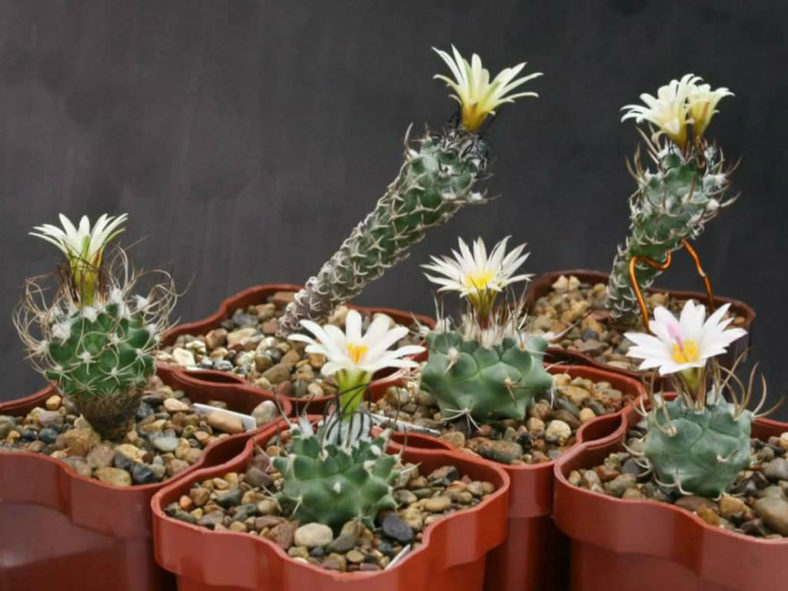Turbinicarpus is a genus of small cacti that inhabit the northeastern regions of Mexico and are extremely popular among collectors. Their small size and readiness to flower contribute to their popularity.
The plants in this genus have small stems often growing hidden in the soil in their habitat. They are often solitary in cultivation, with globose stems with distinct tubercles. Spines vary considerably from species to species. Flowers arise from the stem tips and range from white to dark pink.
Growing Conditions
Light: Turbinicarpus cacti prefer full sun to maintain a good body color and spinal development.
Water: The golden rule when watering Turbinicarpus is "never water when the soil is still wet." This is the one error that will certainly kill any plant! Watering should commence in the spring, depending on the weather conditions. The plants should initially be given a light spray to encourage them to grow. Several species with papery spines, e.g., Turbinicarpus schmiedickeanus, can absorb water through their spines.
Once the plants have swollen after their winter rest, the water can be increased. Water thoroughly at each watering. This should be about every two weeks. Water sufficiently to ensure it runs from the bottom of the pot but try not to water over the plant, especially if it is a hot sunny day, as this can scorch the plant. Always choose a bright sunny day to water and do it in the early morning to allow excess moisture to dry up as soon as possible. During a hot mid-summer period, the plants may go into dormancy for a short time. During this period reduce the water levels. The plants should then remain completely dry for the fall and winter.

Temperature: Turbinicarpus are all able to withstand high summer temperatures and benefit provided accompanied by good ventilation. Do not be tempted to overcrowd the plants; they will be far happier with a bit of space to allow the air to circulate. Winter temperatures can be set as low as 44 to 46 °F (7 to 8 °C), providing the plants are kept dry and the humidity levels are also kept low by good ventilation on bright days. The plants need these low temperatures to ensure a sustained dormant period, resulting in good growth and flowering the following growing season.
Fertilizer: Do not overfeed! Overfeeding and overwatering will produce bloated, unnatural-looking plants that look nothing like the species in the habitat. Remember, these are miniature plants and should, therefore, remain so. One liquid feed per year using a general cactus fertilizer applied during the spring is probably all that is needed.
Repotting
Repotting is best carried out once every two years in early spring, although this can be done at any time of the year with caution. Either clay or plastic pots can be used. Remember, clay pots will dry out quicker. Most Turbinicarpus species will require a deep pot to accommodate the taproot once the plant has matured. Up to this time, shallow pots can be used. Always use a dry compost mix, especially if choosing to repot during the dormant period. Always ensure the plant is dry in the pot before attempting to repot.
Propagation
Unfortunately, most species are solitary and do not produce offsets. Fortunately, most species are easily propagated from seed, and success levels are generally quite good. Seedlings tend to grow away quite quickly and can produce flowering-sized plants within just a few years.
Pests and Problems
Turbinicarpus do not seem to be that susceptible to pests. The one disease that all Turbinicarpus species are susceptible to is rot, which can easily kill any plant within just a few days.
Source: sites.google.com
Links
- Back to genus Turbinicarpus
- Succupedia: Browse succulents by Scientific Name, Common Name, Genus, Family, USDA Hardiness Zone, Origin, or cacti by Genus